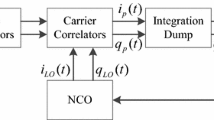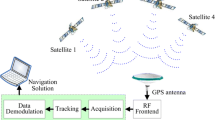Abstract
We present an approach using INS-aided GPS tracking loop with FFT frequency discriminator for tracking of dynamic weak GPS signals. In this approach, the FFT carrier frequency discriminator is used to deal with the attenuated GPS signal, and the INS is used to handle the platform dynamics. With a tactical level INS aiding, when the CN0 of the GPS signal is as low as 19 dB-Hz and the platform dynamic is as high as 100 g, the tracking results indicate that the Doppler tracking error is <4 Hz, and the code loop bandwidth can be decreased to 0.05 Hz. The positioning results show that the positioning error is <5 m and the velocity error is <0.5 m/s.










Similar content being viewed by others
References
Alban S, Akos D, Rock S, Gebre-Egziabher D (2003) Performance analysis and architectures for INS-aided GPS tracking loops. In: Proceedings of ION NTM 2003, Institute of Navigation, Anaheim, CA, USA, January, 611–622
Chiou T (2005) GPS receiver performance using inertial-aided carrier tracking loop. In: Proceedings of ION GNSS 2005, Institute of Navigation, Long Beach, CA, USA, September, 2895–2910
Choi I, Park S, Cho D, Yun S, Kim Y, Lee S (2002) A novel weak signal acquisition scheme for assisted GPS. In: Proceedings of ION GPS 2002, Institute of Navigation, Portland, OR, September, pp 177–183
Curran J, Lachapelle G, Murphy C (2012) Improving the design of frequency lock loops for GNSS receivers. IEEE Trans Aerosp Electron Syst 48(1):850–868
Dedes G, Dempster A (2005) Indoor GPS positioning—challenges and opportunities. In: Proceedings of the IEEE semiannual vehicular technology conference, pp 412–415
Gao G, Lachapelle G (2007) INS-assisted high sensitivity GPS receivers for degraded signal navigation. In: Proceedings of ION GNSS 2006, Institute of Navigation, Fort Worth, TX, USA, 26–29 September, pp 2977–2989
Gautier J, Parkinson B (2001) Using the GPS/INS generalized evaluation tool (GIGET) for the comparison of loosely coupled, tightly coupled and ultra-tightly coupled integrated navigation systems. In: Proceedings of the 59th annual meeting of the institute of navigation and CIGTF 22nd guidance test symposium 2003, Albuquerque, NM, USA, June, pp 65–76
Gebre-Egziabher D, Razavi A, Enge P, Gautier J, Pullen S, Pervan B, Akos D (2005) Sensitivity and performance analysis of Doppler-aided GPS carrier-tracking loops. J Inst Navig 52(2):49–60
Hurd W, Statman J, Vilnrotter V (1987) High dynamic GPS receiver using maximum likelihood estimation and frequency tracking. IEEE Trans Aerosp Electron Syst 23(4):425–437
Kaplan E, Hegarty C (2005) Understanding GPS: principles and applications. Artech House, Boston, p 190
Lashley M, Bevly D, Hung J (2009) Performance analysis of vector tracking algorithms for weak GPS signals in high dynamics. IEEE J Sel Top Signals Process 3(4):661–673
Levanon N, Getz B (1994) Comparison between linear FM and phase-coded CW radars. IEE Proc Radar Sonar Navig 141(4):230–240
Natali F (1984) AFC tracking algorithms. IEEE Trans Commun 32(8):935–947
Niu X, Ban Y, Zhang Q, Zhang T, Zhang H, Liu J (2015) Quantitative analysis to the impacts of IMU quality in GPS/INS deep integration. Micromachines 6:1082–1099
Razavi A, Gebre-Egziabher D, Akos D (2008) Carrier loop architectures for tracking weak GPS signals. IEEE Trans Aerosp Electron Syst 44(2):697–710
Remondi B (2004) Computing satellite velocity using the broadcast ephemeris. GPS Solut 8(3):181–183
Roncagliolo P, De Blasis C, Muravchik C (2006) GPS digital tracking loops design for high dynamic launching vehicles. In: IEEE ninth international symposium on spread spectrum techniques and applications, 2006, pp 41–45
Shanmugam S, Watson R, Nielsen J, Lachapelle G (2005) Differential signal processing schemes for enhanced GPS acquisition. In: Proceedings of ION GNSS 2005, Institute of Navigation, Long Beach, CA, September, pp 212–222
Tsujii T, Fujiwara T, Suganuma Y, Tomita H, Petrovski I (2011) Development of INS-aided GPS tracking loop and flight test evaluation. SICE J Control Meas Syst Integr 4(1):15–21
Wang X, Ji X, Feng S, Calmettes V (2015) A high-sensitivity GPS receiver carrier-tracking loop design for high-dynamic applications. GPS Solut 19(2):225–236. doi:10.1007/s10291-014-0382-8
Yan K, Ziedan N, Zhang H, Guo W, Niu X, Liu J (2014) Weak GPS signal tracking using FFT discriminator in open loop receiver. GPS Solut 20(2):225–237. doi:10.1007/s10291-014-0431-3
Yang C, Nguyen T, Blasch E, Miller M (2008) Post-correlation semi-coherent integration for high-dynamic and weak GPS signal acquisition. In: Position, location and navigation symposium, 2008 IEEE/ION, pp 1341–1349
Zhang J, Zhang K, Grenfell R, Rod Deakin (2006) GPS satellite velocity and acceleration determination using the broadcast ephemeris. J Navig 59(02):293–305
Zhang T, Niu X, Ban Y, Zhang H, Shi C, Liu J (2015) Modeling and development of INS-aided PLLs in a GNSS/INS deeply-coupled hardware prototype for dynamic applications. Sensors. doi:10.3390/s150100733
Ziedan N, Garrison J (2004) Unaided acquisition of weak GPS signals using circular correlation or double-block zero padding. In: Position location and navigation symposium, 2004. PLANS 2004, pp 461–470
Acknowledgements
This work was supported in part by the National Key Research and Development Program of China (No. 2016YFB0501803), the National High Technology Research and Develop Program of China (No. 2015AA124002), the Fundamental Research Funds for the Central Universities (2014618020201) and the National Natural Science Foundations of China (No. 41404029).
Author information
Authors and Affiliations
Corresponding author
Rights and permissions
About this article
Cite this article
Yan, K., Zhang, T., Niu, X. et al. INS-aided tracking with FFT frequency discriminator for weak GPS signal under dynamic environments. GPS Solut 21, 917–926 (2017). https://doi.org/10.1007/s10291-016-0579-0
Received:
Accepted:
Published:
Issue Date:
DOI: https://doi.org/10.1007/s10291-016-0579-0




